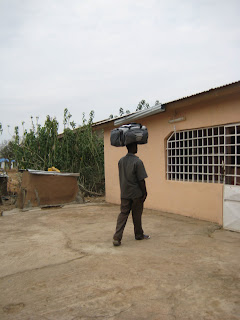They didn't tell us how big the school would be. I was overwhelmed by the population - 450 students in six grades, with
an average of about seventy students per classroom. I looked at the school supplies I had
brought; in all roughly 32 crayons, 40 pens, and 500 sheets of paper. So, from my generous offerings each student
could have approximately one sheet of paper and one-tenth of a writing
utensil. Way to save the world,
Angie. Let the largesse flow forth.
We had a few minutes to walk around and observe the students
in their classrooms, then the bell rang for mid-day break and all of the kids
poured out of their classrooms into the courtyard. And then there were a hundred adorable
schoolchildren congregated in front of me, staring at me, waiting to see what I
would do next. What would I do next? I wasn’t really sure. I hadn’t anticipated having a sudden
audience. So I followed the lead of
another volunteer and took out my digital camera to get a picture of the
group. I sort of understood this would
be a popular thing to do – the kids love having their
picture taken and seeing their faces show up on the display.
I just had no idea HOW popular. Turns out ‘popular’ is a bit of an
understatement.
And that’s how I started a riot amongst a hundred
schoolchildren in Ghana.
 |
| This is just a portion of the group - you have to imagine this extending in a 180-degree arc around you to appreciate the full experience. |
As soon as I turned the camera around all the little faces
in front of me had to see the display LIKE RIGHT NOW. There was pushing, there was shoving, there
were little kids squashed between the shoulders of bigger kids, there were kids
jumping to see over the heads of their classmates. They reminded me of the way koi fish will all
pack in and flop around on top of one another trying to reach a lone crust of
bread. Laughter, cheers, pointing,
grabbing. I don’t think anyone was hurt
and they all seemed pretty happy, but I’m glad they’re sturdy. This went on for several minutes. I don’t think the kids ever got tired of
seeing the display, but I did, so eventually I had to just shut it off and put
it back in my pocket. And then we were
back to square one – what to do now?
I made a semi-theatrical turn and took two steps away, then
looked over my shoulder. They all
giggled and followed me. I put my arms
at my sides, hands out, shuffled penguin-style.
They did the same. And the game
was established. I raised my hands
overhead and saw two hundred hands shoot up in reply. I made airplane arms and swooped in a
semi-circle around the schoolyard and created a hundred mini-airplanes
following in my wake. I assume this is
what being God feels like. I can only
imagine how awesome teaching group fitness here would be (not that they need
it, of course – alas, the people easiest to teach are the ones that don’t need
to be taught).  |
| Me and some of my mini-airplanes. This was some of the best fun I had on the trip. |
The kids I encountered in Ghana were a joy. Part of that may be simply because everyone, young and old, is eager
to meet and please American visitors. And then, part of it too may be the things
their upbringing does right. Don't worry, I'm not about to launch a "that's what wrong with kids/parents today!" diatribe. I'm not a fan of blanket statements of how kids should and shouldn't be raised (especially from people that don't have any - like myself), and I'm not comfortable stamping my foot and saying it's the limited media influence, or the relative lack of junk food, or the corporal punishment, or the religion, or the family, or their access to nature, or any of several dozen other influences, that affected the behavior I witnessed. But I can say, based on admittedly limited observation, that the kids I met seemed pretty content. The babies don’t constantly
fuss. They sit or lie wrapped up on
Mom’s back and watch the world from their vantage point with hardly a
peep. The kids in tow behind Mom and/or
Dad are content to sit and watch their parents while they work, or they find
quiet ways to entertain themselves with simple toys like a stick and a
half-deflated rubber ball. They get
excited by new shiny things like digital cameras, but not greedy, not desperate
– not competitive, I don’t think.
They’re not brats, I guess is what I’m saying. Just … happy.


















